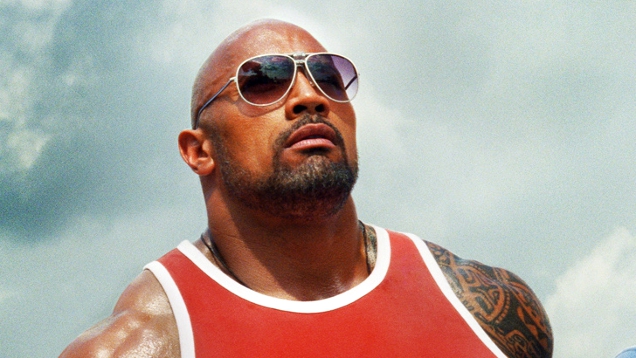The Rock’s most under-rated movies

He’s shaped like a Greek god and built like a brick shit house. Dwayne Johnson aka The Rock is an amazing screen presence, though the critics don’t always appreciate his films. Luke Buckmaster says sometimes the critics are wrong – and picks three under-rated The Rock movies to argue the point.
Most critics have given a reasonably enthusiastic thumbs up to Dwayne ‘The Rock’ Johnson’s latest film Fighting With Family, which arrives in Australian cinemas this week. Many of them, such as Flicks’ Craig Mathieson, have put some caveats around a largely positive experience, with Mathieson for instance describing the WWE-produced biopic as “pleasing but hardly challenging.” The film benefits from Johnson’s muscle, in terms of both his celebrity clout and bulging biceps, the wrestler-cum-actor being a powerful marketing force as well as an unmissable presence on screen.
The Rock is among Hollywood’s highest paid actors, with many hits attached to his name. Reviews of his films vary, of course, with Johnson no stranger to a critical smackdown. There’s lots of crap on his resume, though I dare say that not all the maulings have been entirely deserved. Here are three films that copped a poor critical response (measured by a Rotten Tomatoes rating of 50% or less) but get a thumbs up from me. The Get Shorty sequel Be Cool (sitting on 30%) was one of the titles that came reasonably close to making it onto this list, but its splotchy structure, semi-meta waffle and weirdly gooey tone make it difficult for me to recommend.
Pain & Gain (50% on Rotten Tomatoes)
“I just want a big fat lawn I can mow until the sun comes down,” says airheaded personal trainer Daniel Lugo (Mark Wahlberg), whose aspirations sound modest until one discovers how he intends to achieve them. The plan involves teaming up with born again beefcake Paul Doyle (Johnson) and extorting an obnoxious millionaire (Tony Shalhou). When we hear the aforementioned words, that scene, which involves artificial grass and Mark Wahlberg straddling a ride on mower, unfolds like a bizarre counterpoint to Somewhere That’s Green: modest, like Ellen Greene’s fantasy of microwave dinners and Pine-Sol scented air, but fuelled by great yearning, connecting personal aspiration to national character.
Michael Bay’s real life-inspired crime drama, in other words, is about chasing the American Dream; for better or worse this is his Great Gatsby. That is by no means a bold interpretation. When The Rock inspects the packaging of a huge dildo, he gazes at the words “THE GREAT AMERICAN CHALLENGE” brandished on it. So yeah, we get it. The director’s restless style thrillingly suits the script’s appraisal of modern America as a cesspool of slick surfaces and painted-on ideologies. Bay’s best film is still, by far, the magnificent 1996 action movie The Rock (unrelated to our boy Dwayne) but Pain & Gain is a good’un: an edgy and invigorating film that cleverly matches form and content.
Skyscraper (47% on Rotten Tomatoes)
In this preposterous but deceptively intelligent popcorn flick, the biblical concept of a Tower of Babel is revisited through the construction of a skyscraper that’s marketed as a utopian solution to the ills of day-to-day life. It is in effect a science fiction premise, not dissimilar to dystopian social allegories such as High Rise and – literally stretching horizontally rather than vertically – the train-set Bong Joon-ho film Snowpiercer. The verticality of the central setting in Skyscraper accommodates a goal-based storyline spearheaded by security expert Will (Johnson), who must literally go up and down in order to save his family when fire spreads through the building.
Writer/director Rawson Marshall Thurbe engineers the kind of spatial clarity we expect of an old fashioned platform video game such as Donkey Kong. It is always clear where the protagonist is and where he is needed. Up and right to reach a certain point in the building, for example, then down to save one member of his family, then up again to save somebody else, etcetera.
That in itself doesn’t make the film a valuable time investment, but it does represent an uncluttered approach reflected in other areas – such as the narrative efficiency of the script and its clear-cut themes. It’s a shame that corny ‘stick together’ elements were written in highlighter pen and mashed into the audience’s faces like a custard pie. But in Dwayne Johnson’s oeuvre we accept the good with the bad.
Southland Tales (38% on Rotten Tomatoes)
The much-maligned second film from writer/director Richard Kelly, who broke through in a big way with his 2001 cult classic Donnie Darko, is a strange beast. It is a very good bad movie and a very bad good movie. You don’t so much watch it as come to terms with it. Based in an ‘alternate history’ Los Angeles, circa 2008, the film begins in post-apocalyptic style, with nuclear bombs and an assumption of impending anarchy. But this version of America is still a relatively functioning society, Kelly exploring various semi-satirical pathways, into the domain of tub-thumping politicians and infomercial-powered charlatans (more specifically, a psychic ex-porn star played by Sarah Michelle Gellar).
Johnson plays Boxer Santaros, a movie star afflicted with amnesia. He (Johnson, not Santaros) over-acts and comes across as cartoonish, the performance a reminder that Johnson’s acting skills have improved considerably over the years. Southland Tales is shaggy, derivative and maddeningly plotted – but tonally it gels, and there are times when one cannot help but admire its gall. If Southland Tales were made today it would probably take the form of a television series, a more accommodating format for its open world ideas and sprawling storylines.















